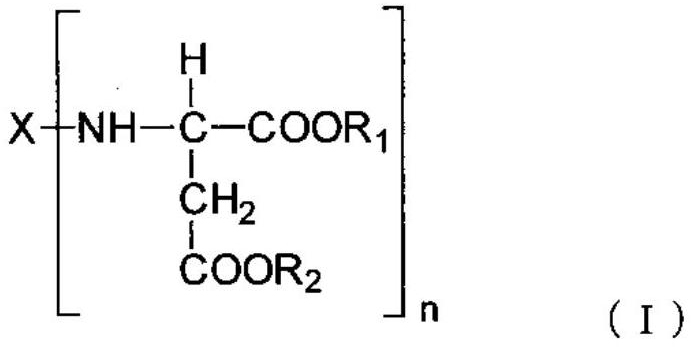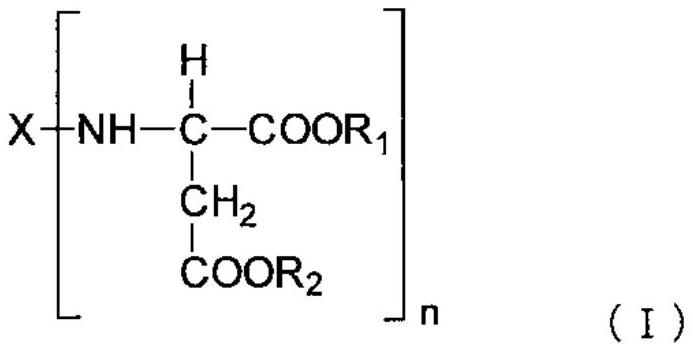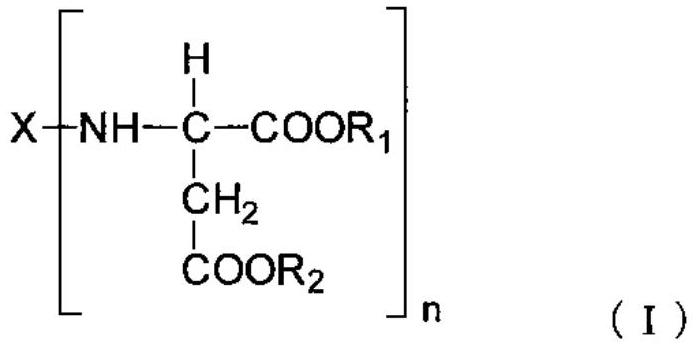Polyaspartic acid coating composition, coating film, and coated article
A technology of polyaspartic acid and aspartic acid ester, applied in polyurea/polyurethane coatings, polyamide coatings, anti-corrosion coatings, etc., to achieve the effects of maintaining dryness, excellent chemical resistance, and excellent weather resistance
- Summary
- Abstract
- Description
- Claims
- Application Information
AI Technical Summary
Problems solved by technology
Method used
Image
Examples
Embodiment
[0324] Hereinafter, although an Example demonstrates this embodiment in more detail, this embodiment is not limited to these Examples. Hereinafter, methods for measuring various physical properties and various evaluations will be described. In addition, "part" and "%" mean "part by mass" and "% by mass" unless otherwise specified.
[0325] (Physical properties 1) NCO content (mass%)
[0326] The NCO content (isocyanate content, mass %) of the polyisocyanate was measured as follows. Accurately weigh (Wg) 1-3 g of the polyisocyanate produced by the production example in the Erlenmeyer flask, add 20 mL of toluene, and dissolve the polyisocyanate completely. Thereafter, 10 mL of a toluene solution of 2 equivalents of di-n-butylamine was added, mixed completely, and then left to stand at room temperature for 15 minutes. Furthermore, 70 mL of isopropanol was added to this solution, and it mixed completely. Titrate the solution with 1 N hydrochloric acid solution (factor F) using...
manufacture example 1-1
[0399] A 4-necked flask equipped with a stirrer, a thermometer, a reflux condenser, a nitrogen blowing tube, and a dropping funnel was made into a nitrogen atmosphere, and 100 parts of HDI were put into it, and the temperature in the reactor was kept at 60° C. while stirring. 0.15 parts of a solution obtained by diluting tetrabutylammonium acetate, an isocyanurate reaction catalyst, to 10% by mass with 2-ethyl-1-hexanol was added thereto, and the isocyanurate reaction was carried out. When the NCO content of the liquid became 43.8% by mass, phosphoric acid was added to stop the reaction. Thereafter, the reaction solution was kept at 90° C. for 1 hour. After the cooled reaction solution was filtered, the unreacted HDI was removed with a thin film evaporation tank. The obtained NCO content is 23.1% by mass, the viscosity at 25°C is 1350mPa.s, the number average molecular weight is 590, the average number of isocyanate groups is 3.2, the mass concentration of HDI monomer is 0.1%...
manufacture example 1-2
[0401]Make a nitrogen atmosphere in the 4-neck flask equipped with a stirrer, a thermometer, a reflux condenser, a nitrogen blowing pipe, and a dropping funnel, and drop 100 parts of HDI and 33.7 parts of polycaprolactone triol with a number average molecular weight of 850, and react under stirring. The temperature in the vessel was kept at 95° C. for 90 minutes to carry out the urethanization reaction. After the cooled reaction solution was filtered, the unreacted HDI was removed with a thin film evaporation tank. The obtained NCO content is 9.0% by mass, the viscosity at 25°C is 4980mPa.s, the number average molecular weight is 1520, the average number of isocyanate groups is 3.3, the mass concentration of HDI monomer is 0.2% by mass, and the content of isocyanurate trimer is 0.0% by mass % of polyisocyanate P1-2.
PUM
| Property | Measurement | Unit |
|---|---|---|
| viscosity | aaaaa | aaaaa |
| viscosity | aaaaa | aaaaa |
| viscosity | aaaaa | aaaaa |
Abstract
Description
Claims
Application Information
 Login to View More
Login to View More - R&D
- Intellectual Property
- Life Sciences
- Materials
- Tech Scout
- Unparalleled Data Quality
- Higher Quality Content
- 60% Fewer Hallucinations
Browse by: Latest US Patents, China's latest patents, Technical Efficacy Thesaurus, Application Domain, Technology Topic, Popular Technical Reports.
© 2025 PatSnap. All rights reserved.Legal|Privacy policy|Modern Slavery Act Transparency Statement|Sitemap|About US| Contact US: help@patsnap.com



